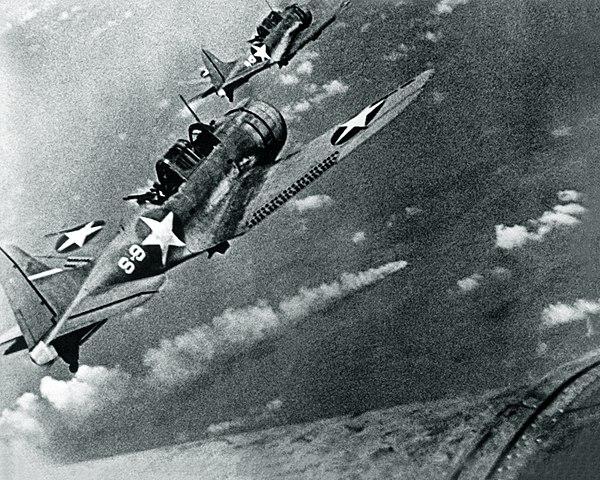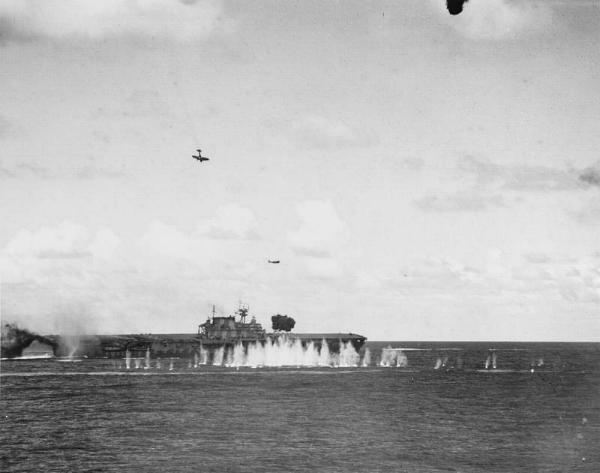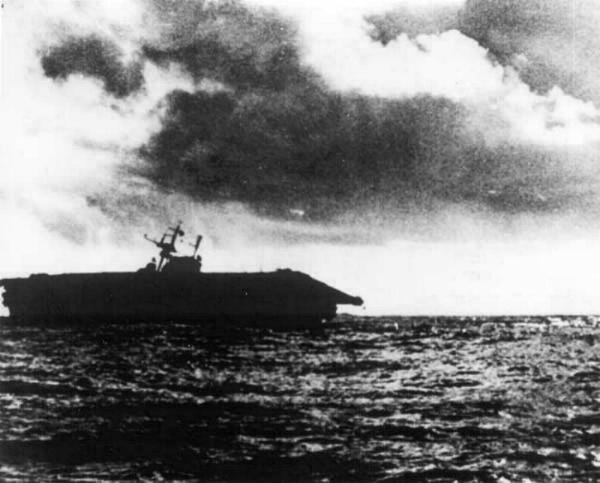
|
|

|
USS Hornet and USS Nashville War Diary's
Battle of Midway, June 1942
Watch the movie: Midway
2 hours 6 minutes

SBDs from Hornet at Midway
On 28 May 1942, Hornet and Task Force 16 steamed out of Pearl Harbor heading for Point "Luck",
an arbitrary spot in the ocean roughly 325 miles (523 km) northeast of Midway, where they would
be in a flank position to ambush Japan's mobile strike force of four frontline aircraft carriers, the
Kido Butai. Japanese carrier-based planes were reported headed for Midway in the early morning
of 4 June. Hornet, Yorktown, and Enterprise launched aircraft, just as the Japanese carriers struck
their planes below to prepare for a second attack on Midway. Hornet dive bombers followed an
incorrect heading and did not find the enemy fleet. Several bombers and all of the escorting fighters
were forced to ditch when they ran out of fuel attempting to return to the ship. Fifteen torpedo
bombers of Torpedo Squadron 8 (VT-8) found the Japanese ships and attacked. They were met
by overwhelming fighter opposition about eight nautical miles (9 mi; 15 km) out, and with no escorts
to protect them, they were shot down one by one. Ensign George H. Gay, USNR, was the only
survivor of 30 men.
Further attacks by Enterprise and Yorktown torpedo planes proved equally disastrous, but succeeded
in forcing the Japanese carriers to keep their decks clear for combat air patrol operations, rather than
spotting a counter-attack against the Americans. Japanese fighters were shooting down the last of the
torpedo planes over Hiryu when dive bombers of Enterprise and Yorktown attacked, starting enormous
fires aboard the three other Japanese carriers that led to their loss. Hiryu was hit late in the afternoon
of 4 June by a strike from Enterprise and sank early the next morning. Hornet aircraft, launching late due
to the necessity of recovering Yorktown scout planes and faulty communications, attacked a battleship
and other escorts, but failed to score hits. Yorktown was lost to combined aerial and submarine attack.
Hornet's warplanes attacked the fleeing Japanese fleet on 6 June and they assisted in sinking the heavy
cruiser Mikuma, damaging a destroyer, and leaving the heavy cruiser Mogami, heavily damaged and on fire,
to limp away from the battle zone. The attack by the Hornet's on the Mogami ended one of the great
decisive battles of naval history. Midway Atoll was saved as an important base for American operations into
the Western Pacific Ocean. Of greatest importance was the crippling of the Japanese carrier strength, a
severe blow from which the Imperial Japanese Navy never fully recovered. The four large carriers took
with them to the bottom about 250 naval aircraft and a high percentage of the most highly trained and
experienced Japanese aircraft maintenance personnel. The victory at Midway was a decisive turning point
in the War in the Pacific.
On 16 June 1942, Captain Charles Perry Mason became commanding officer of Hornet upon her return to
Pearl Harbor. Hornet spent the next six weeks replenishing her stores, having minor repairs performed,
and most importantly having additional light anti-aircraft guns and the new RCA CXAM air-search radar
fitted. She did not sail in late July with the forces sent to re-capture Guadalcanal, but instead remained at
Pearl Harbor in case she was needed elsewhere.
|
Solomons campaign, August-October, 1942
Hornet steamed out of harbor on 17 August 1942 to guard the sea approaches to bitterly contested
Guadalcanal in the Solomon Islands. Bomb damage to Enterprise on 24 August, torpedo damage to Saratoga
on 31 August, and the sinking of Wasp on 15 September left Hornet as the only operational U.S. carrier in
the South Pacific. She was responsible for providing air cover over the Solomon Islands until 24 October 1942,
when she was joined by Enterprise just northwest of the New Hebrides Islands. These two carriers and their
escorts then steamed out to intercept a Japanese aircraft carrier/battleship/cruiser force closing in on
Guadalcanal. |
Battle of the Santa Cruz Islands

Japanese aircraft attack USS Hornet (CV-8) during the Battle of Santa Cruz Islands
The Battle of the Santa Cruz Islands took place on 26 October 1942 without contact between surface ships of the
opposing forces. That morning, Enterprise's planes bombed the carrier Zuiho, while planes from Hornet
severely damaged the carrier Shokaku and the heavy cruiser Chikuma. Two other cruisers were also attacked
by Hornet's warplanes. Meanwhile, Hornet was attacked by a coordinated dive bomber and torpedo
plane attack. In a 15-minute period, Hornet was hit by three bombs from Aichi D3A "Val" dive bombers. One
"Val", after being heavily damaged by anti-aircraft fire while approaching Hornet, crashed into the carrier's
island, killing seven men and spreading burning Avgas over the deck. Meanwhile, a flight of Nakajima B5N
"Kate" torpedo planes attacked Hornet and scored two hits, which seriously damaged the electrical
systems and engines. As the carrier came to a halt, another damaged "Val" deliberately crashed into Hornet's
port side near the bow.
With power knocked out to her engines, Hornet was unable to launch or land aircraft, forcing its aviators to
either land on Enterprise or ditch in the ocean. Rear Admiral George D. Murray ordered the heavy cruiser
Northampton to tow Hornet clear of the action. Since the Japanese planes were attacking Enterprise,
this allowed Northampton to tow Hornet at a speed of about five knots (9 km/h; 6 mph). Repair
crews were on the verge of restoring power when another flight of nine "Kate" torpedo planes attacked. Eight of
these aircraft were either shot down or failed to score hits, but the ninth scored a fatal hit on the starboard side.
The torpedo hit destroyed the repairs to the electrical system and caused a 14-degree list. After being informed
that Japanese surface forces were approaching and that further towing efforts were futile, Vice Admiral William
Halsey ordered Hornet sunk, and an order of "abandon ship" was issued. Captain Charles P. Mason, the
last man on board, climbed over the side, and the survivors were soon picked up by the escorting destroyers.
American warships next attempted to scuttle the stricken carrier, which absorbed nine torpedoes, many of which
failed to explode, and more than 400 5-inch (130 mm) rounds from the destroyers Mustin and Anderson.
The destroyers steamed away when a Japanese surface force entered the area. The Japanese destroyers
Makigumo and Akigumo finally finished off Hornet with four 24-inch (610 mm) Long Lance
torpedoes. At 01:35 on 27 October, Hornet was finally sunk with the loss of 140 of her sailors.
Hornet was struck from the Naval Vessel Register on 13 January 1943. However, her name was revived less
than a year later when the newly constructed Essex-class aircraft carrier Kearsarge was commissioned
as USS Hornet (CV-12).
Other than the light carrier Princeton and a number of smaller escort carriers,Hornet was the last American
fleet carrier ever sunk by enemy fire. |

Hornet sinking and abandoned
USS Hornet and USS Nashville War Diary's
USS Morris (DD-417) first found in USS Helena CL-50 War Diary for 2 September 1942,

USS Morris (DD-417), a World War II-era Sims-class destroyer in the service of the
United States Navy, was named after Commodore Charles Morris. Morris was laid
down at the Norfolk Navy Yard, Portsmouth, Virginia, on 7 June 1938; launched on
1 June 1939, sponsored by Mrs. Charles R. Nutter, great-granddaughter of Commodore
Morris; and commissioned on 5 March 1940, with Commander Harry B. Jarrett in command. |
History
Builder: Norfolk Navy Yard, Portsmouth, Virginia
Laid down: 7 June 1938
Launched: 1 June 1939
Commissioned: 5 March 1940
Decommissioned: 9 November 1945
Struck: 28 November 1945
Honors and
awards: American Defense Service Medal ("Fleet" clasp, "A" device),
Asiatic-Pacific Campaign Medal (15 stars), World War II Victory Medal
Fate: Sold on 2 August 1947, scrapped
General characteristics
Class and type: Sims-class destroyer
Displacement:
1,570 long tons (1,600 t) (std)
2,211 long tons (2,246 t) (full)
Length: 348 ft, 3¼ in, (106.15 m)
Beam: 36 ft, 1 in (11 m)
Draft: 13 ft, 4.5 in (4.07 m)
Propulsion: High-pressure super-heated boilers,
geared turbines with twin screws, 50,000 horsepower
Speed: 35 knots
Range: 3,660 nautical miles at 20 kt (6,780 km at 37 km/h)
Complement: 192 (10 officers/182 enlisted)
Armament:
5 × 5 inch/38, in single mounts
4 × .50 caliber/90, in single mounts
8 × 21 inch torpedo tubes in two quadruple mounts
2 × depth charge track, 10 depth charges
Morris, flagship of Destroyer Squadron 2 (DesRon 2), followed her shakedown with routine
training schedules until the summer of 1941 when she joined the North Atlantic Patrol. With
the entry of the United States into World War II, she entered Charleston Navy Yard, where
she was equipped with the first fire control radar for a destroyer. By 3 January 1942, she was
underway for Pearl Harbor, rejoining her squadron there at the end of February.
Attached to Task Force 17 (TF 17), the destroyer sailed on 16 March for Noumea, and into
her first major enemy engagement, the Battle of the Coral Sea. Prior to the battle, she guarded
the carriers of the task force as their planes struck at enemy shipping in Tulagi Harbor and in
the Louisiade Archipelago. From 4-8 May, she splashed one enemy plane and damaged two
while screening Yorktown and Lexington, and when the latter was heavily damaged, pulled
alongside to rescue some 500 survivors. Damage received during the rescue forced her back
to Pearl Harbor where hurried repairs put her back into condition for the Battle of Midway a month
later. In that action she again pulled alongside Yorktown to rescue over 500 survivors.
Morris's next action came in late August, when she joined TF 61 in support of the Guadalcanal
Campaign. For the next 2 months, she screened carriers and patrolled among the Solomon Islands.
On 25 October, following a 3-day independent sweep through the Gilbert Islands, she rejoined
TF 17 and took part in the Battle of the Santa Cruz Islands. During the action, she destroyed six
aircraft and once more came to the rescue of Hornet, from which she took on 550 survivors. As
in other rescue operations her superstructure was damaged, but, after repairs at Espiritu Santo,
she was back in the Guadalcanal area, first operating with Enterprise and then as supply unit
escort to Russell.
In May 1943, Morris departed the southern Pacific and sailed north to support the capture and
occupation of Attu Island and Kiska, the Aleutian end of the Japanese ribbon defense. Then she
returned to San Francisco, California for a 7-week overhaul. In November, she again joined an air
support group escorting Liscome Bay, Coral Sea, and Corregidor in the Gilberts offensive, during
which she went to aid Liscome Bay. As the task forces pressed further into the central Pacific,
Morris sailed with them into the Marshall Islands. On 30 January 1944, she led a column of warships
in a shore bombardment mission against Wotje Atoll. Thence she steamed to Kwajalein Atoll,
where, while providing close fire support off Namur, she wiped out a Japanese counterattack force
from an adjacent island. In mid-February she departed Kwajalein and moved with TG 51.11 to
support the seizure and occupation of Eniwetok. Arriving on 17 February, she continued carrier
operations until 24 February, when she sailed for Pearl Harbor. |





